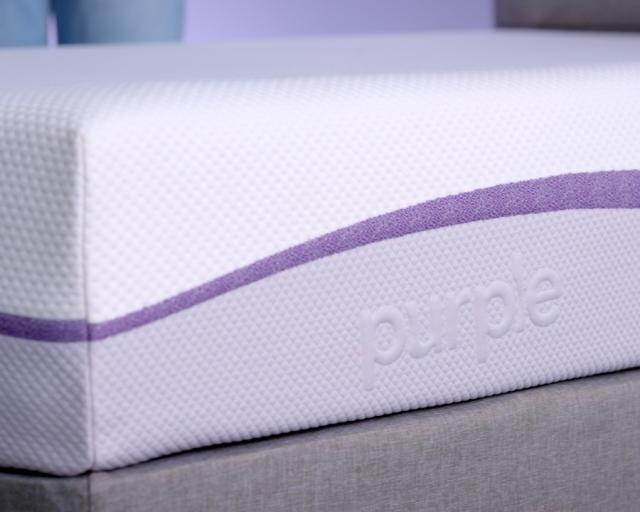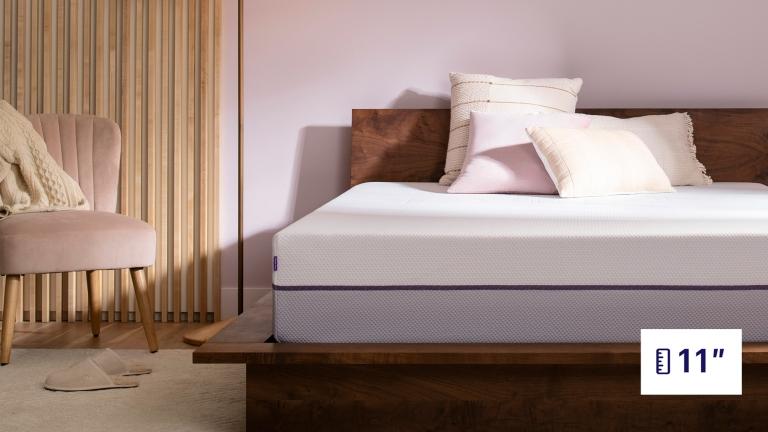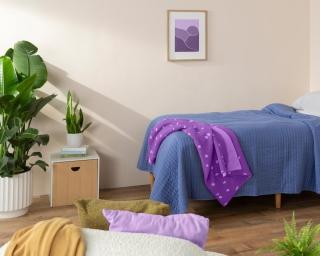Single vs. Twin Bed: What's The Difference? [2025 Comparison Guide]
Key Takeaways
- Single and twin beds are the same size, measuring 38 inches in width and 75 inches in length.
- Both are suited for solo sleepers under 6 feet tall, like children, teens, college students, and small adults.
- Twins and singles are the smallest and most budget-friendly standard mattress sizes, making them perfect for guest rooms and other small spaces.
In your search for what size bed to get, have you been weighing a single vs. twin bed? Good news: There’s no need! A single and a twin are the same thing.
“Single” used to be the preferred term for this mattress size, indicating it was large enough for a single sleeper. As the mattress market changed over time, the term “single” gave way to “twin,” which is now more universal.
Still, you may not be sure if this bed size is right for your space. Let’s break down the pros and cons of single and twin beds, who they’re best suited for, and final considerations to help you feel 100% confident in your next mattress purchase.
Single vs. Twin Bed Dimensions Comparison
A single bed’s dimensions are 38 inches wide by 75 inches long. These are the exact same dimensions as a twin bed. Single/twin beds are the smallest standard bed sizes on the market.
Manufacturers often sell twin mattresses in pairs for bunk beds and shared children’s rooms, but it's also common to use them for guest rooms and other small spaces. Additionally, you can place them side by side to form a larger bed for more than one person.
So what’s the difference between a twin vs a twin XL? The twin XL has dimensions similar to a twin but with an additional length of five inches. This extra five inches means you can also use two twin XLs in a room as a split king. While the regular twin size mattress caters to kids and short adults, a twin XL is most suitable for taller sleepers.
Single or Twin Bed | Twin XL Bed | |
Width | 38” | 38” |
Length | 75” | 80” |
Cost | $999 (The Purple Mattress®) | $1,099 (The Purple Mattress®) |
Best for | Solo sleepers under six feet tall | Solo sleepers over six feet tall |
What Is a Single Bed?
Dimensions: 38-by-75 inches
The size of a single bed is 38 inches wide and 75 inches long.
The term “single bed” is slightly outdated. It once referred to one of two standard bed sizes: singles and doubles. The name “single” indicated that the bed could fit one person, while a “double” could fit two people.
When king and queen sized mattresses, both of which could fit two people, were introduced to the market in the 1950s, the terminology changed. Eventually, the term “single” dropped off in favor of the term “twin.” The name “twin” stems from the fact that they were often one of a pair, as in hotel rooms. Many people now use them individually, though.
While “twin” is the more common term now, some people still use the name “single” to refer to this bed size.
Single and Twin Mattress Size Variations
There are two specialty size variations of the single/twin mattress:
- Small single: A small single mattress is 30 inches wide and 75 inches long, eight inches narrower than a standard single/twin. This specialty size mattress may be a good fit for small children. It’s also a good alternative for when a spare bedroom is super tight on space.
- Twin XL: A twin XL mattress is five inches longer than a twin/single, so its dimensions are 38 inches wide by 75 inches long. The extra five inches of a twin XL may make the bed a more comfortable alternative to a twin for a taller sleeper, like a growing teenager or young adult.
Pros and Cons of a Single Bed
Now that you know there’s no difference between single and twin beds, let’s weigh their pros and cons.
If you plan to maximize your personal space to make room for other furniture, provide your child with an appropriate sleeping area, or furnish vacation homes for future use, the single or twin mattress size could be right up your alley.
Although people who sleep alone sometimes prefer a larger bed size, a single or twin XL bed can also do wonders. Here are more benefits and drawbacks of a single bed to consider:
Pros | Cons |
Compact & space efficient | Only fits one person comfortably |
Most budget-friendly standard size | Tall individuals may feel cramped |
Lightweight and easy to move around | Not large enough to move around a lot in sleep |
Maximizes floor space for storage solutions | Children may outgrow it |
Who Should Buy a Single or Twin Bed?
Here’s who a twin bed is best for:
- Children: Because of their narrow width, single or twin size beds are excellent mattresses for kids, especially those aged 4 to 12. Two twins are great for siblings sharing a room, providing comfort and adequate space to sleep and have fun.
- Adults: Shorter adults under six feet can sleep comfortably on twin or single beds. If you're taller than six feet, consider a twin XL bed for a few more inches of legroom.
- Those with guest rooms or vacation homes: Single and twin beds are the perfect budget-friendly options to furnish rental properties like vacation homes.
Considerations When Choosing a Single or Twin Mattress Size
Here are the final factors to weigh before choosing a single or twin mattress for your space.
Room Size
Unlike their bigger counterparts — like a king or queen — twin beds easily slip into small rooms. Whether it's a twin XL variation or not, a twin mattress is flexible and versatile.
Twins and singles fit nicely into rooms at least 7 feet by 10 feet. They leave enough space for furniture like nightstands and bookshelves.
Consider a bigger bed for spacious primary bedrooms. Compare kings and queens to determine which will best fill a larger space and allow couples ample room.
Budget
If you're anxious about your budget and wondering how much you should spend on a mattress, you will love the low prices of single and twin beds. Because twins are the smallest standard mattress size on the market, they are also the most affordable.
This low starting cost makes for a great mattress deal, as you can still get the features of a high-quality mattress (e.g., optimal temperature, instant response, and pressure reduction) without breaking the bank.
Saving on a twin mattress can also allow you to allocate more of your budget to accessories, like an upholstered bed frame or luxurious sheets. For the most comfortable sleep experience, choose a bed frame size that matches your mattress size.
Mattress Composition
Though the size of the mattress has no impact on its composition, you should consider mattress firmness and thickness when choosing a mattress brand to buy from.
Just because a twin mattress is smaller doesn’t mean you have to sacrifice comfort and quality. Different sleepers will have different needs when it comes to comfort, and you still have many options to choose from when it comes to twin mattresses.
Your body weight and preferred sleeping position will help determine which mattress firmness is best for you. For example, a heavier sleeper might benefit from a firmer mattress that will support their spinal alignment, while a lighter sleeper might benefit from a softer feel. The best way to find out what’s right for you is by trying it out.
Number of Sleepers
A single or twin bed is ideal for one to two young children or one adult sleeper. A twin XL or full-size mattress is recommended for taller sleepers.
While a regular twin size mattress can work for a single adult, it’s too narrow for couples to share the bed comfortably. If you want to add another sleeper, a queen mattress is more ideal than a twin. A queen is wider, allowing more flexibility for more than one person to move around, play with kids or pets, and stretch out.
Sleeper Height
A twin mattress may be a good option for children until around high school age, give or take, depending on their height. Generally, a twin mattress will provide enough room for someone six feet or shorter. You may not have enough legroom in a twin bed if you are six feet tall or taller.
With its extra five inches, a twin XL may provide more comfort for a taller sleeper. A queen or king is an even more spacious upgrade, allowing extra width to spread out.
Sleep Habits
Your sleeping habits are also important to consider. If you toss and turn or like to spread out like starfish at night, you may feel too confined by a single/twin’s narrow shape.
If you sleep on your side, choose a twin mattress that will soften around your hips and shoulders while letting you maintain a straight posture. For back sleepers, choose a mattress that allows your spine to straighten while sinking your back, head, and arms.
If you are a stomach sleeper, your mattress of choice should keep your backbone straight while supporting your arms and stomach.
If you’re purchasing the bed for a hot sleeper, you’ll need to choose a twin size mattress with cooling capabilities.
If you experience back pain at night, you’ll need a mattress that adequately supports your pressure points and ensures a combination of spinal support and softness.
Find the Right Fit With Purple
While twins and singles share the same mattress dimensions, there are plenty of other factors to consider before making the purchase. We hope this guide has helped you better understand single vs. twin beds and how selecting the right mattress goes beyond specs and dimensions.
With sleeper size, room solutions, and mattress composition in mind, you’re ready to create a cozy haven that perfectly fits your needs.
FAQ
No. A single bed, also known as a twin bed, is 38 by 75 inches, while a full size bed measures 54 inches by 75 inches. When comparing a single or twin vs. a full bed, remember that a single bed is best for solo sleepers such as children, teens, and adults under six feet tall. A full size mattress is best for tall teens and adults who need more bedroom space in their studio apartments or homes.
Yes, small singles and crib mattresses are smaller than twins. Twins (38 by 75 inches) are the smallest standard bed size carried by most mattress manufacturers. Small singles are specialty mattresses measuring 30 by 75 inches. Crib mattresses for infants are around 28 by 52 inches. Mini cribs are about 24 by 38 inches, and bassinets are roughly 15 by 30 inches.
A child typically transitions from their crib to a twin bed anywhere between 18 and 30 months old. This major growth milestone is highly dependent on the individual child, and it’s ultimately the parent’s decision when to make the switch. Adjust to your child's pace and keep an eye on transition signals to maintain your little one’s comfort.
Almost, but not quite. Pushing two twin beds together makes a bed that’s the same width as a king bed, but it’s five inches shorter than a king. To create a bed that’s the exact dimensions of a king, you’ll need to push together two twin XLs.
No. Generally, two adults cannot sleep comfortably on a twin bed. Twin beds are only 38 inches wide, which doesn’t leave a lot of room. Two small adults may be able to cuddle up close on a twin bed if needed, but it’s not an ideal, long-term situation. The best option for two adults is to upgrade to a queen or king bed.
More To Explore
Level up your sleep routine with our most-loved products.







